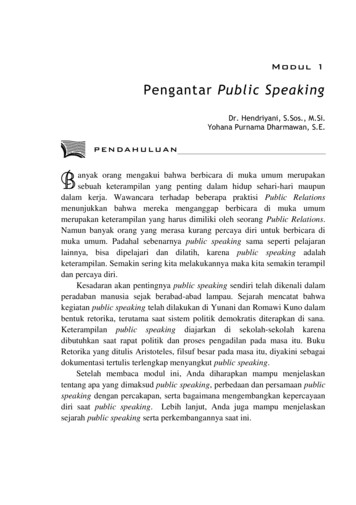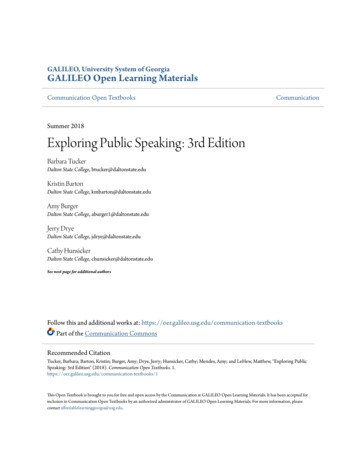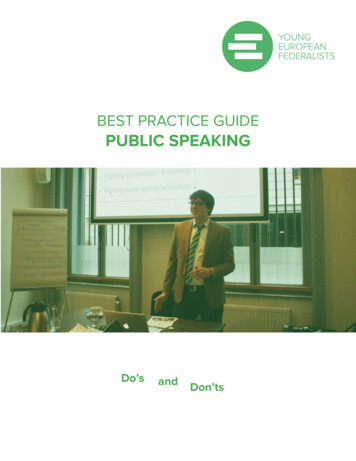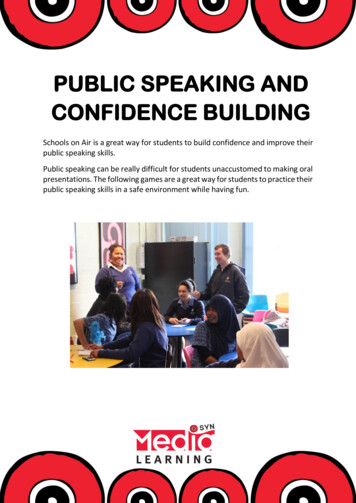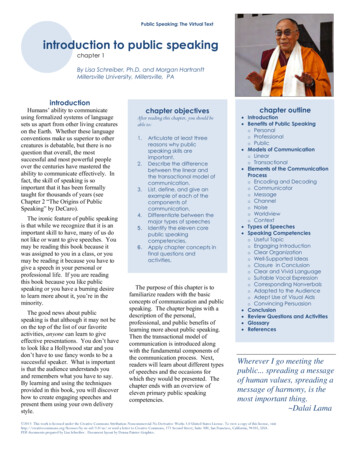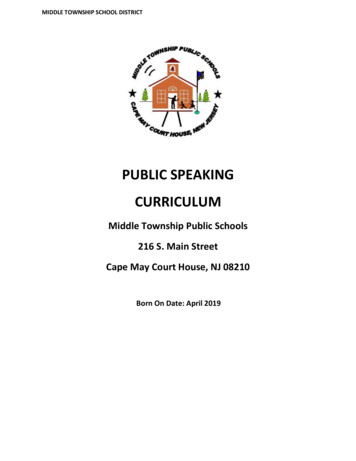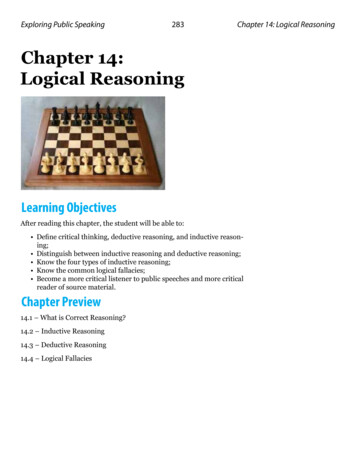
Transcription
Exploring Public Speaking283Chapter 14: Logical ReasoningChapter 14:Logical ReasoningLearning ObjectivesAfter reading this chapter, the student will be able to: Define critical thinking, deductive reasoning, and inductive reasoning; Distinguish between inductive reasoning and deductive reasoning; Know the four types of inductive reasoning; Know the common logical fallacies; Become a more critical listener to public speeches and more criticalreader of source material.Chapter Preview14.1 – What is Correct Reasoning?14.2 – Inductive Reasoning14.3 – Deductive Reasoning14.4 – Logical Fallacies
Exploring Public Speaking284Chapter 14: Logical Reasoning14.1 – What is Correct Reasoning?Analogicalreasoningdrawing conclusionsabout an object or phenomenon based on itssimilarities to something elseFigurative analogyan analogy where thetwo things under comparison are not essentially the sameLiteral analogyan analogy where thetwo things under comparison have sufficientor significant similarities to be comparedfairlyLogical fallaciesmistakes in reasoning;erroneous conclusionsor statements madefrom poor inductive ordeductive analysesIn Chapter 13, we reviewed ancient and modern research on how to createa persuasive presentation. We learned that persuasion does not just depend on one mode, but on the speaker using his or her personal credibilityand credentials; understanding what important beliefs, attitudes, values,and needs of the audience connect with the persuasive purpose; and drawing on fresh evidence that the audience has not heard before. In additionto fresh evidence, the audience expects a logical speech and to hear arguments that they understand and to which they can relate. These are historically known as ethos, pathos, and logos. This chapter will deal with thesecond part of logos, logical argument and using critical thinking to fashion and evaluate persuasive appeals.We have seen that logos involves composing a speech that is structured ina logical and easy-to-follow way; it also involves using correct logical reasoning and consequently avoiding fallacious reasoning, or logical fallacies.Although it is not a perfect or literal analogy, we can think of correct reasoning like building a house. To build a house, you need materials (premises and facts) a blueprint (logical method), and knowledge of buildingtrades (critical thinking ability). If you put a person out in a field with drywall, nails, wiring, fixtures, pipes, and wood and handed him a blueprint,he would need knowledge of construction principles, plumbing, and reading plans (and some helpers), or no building is going up. Logic could alsobe considered like cooking. You need ingredients, a recipe, and knowledgeabout cooking. In both cases, your ingredients or materials must be goodquality (your information and facts must be true); your recipe or directions must be right (the logical process); and the user must know what heor she is doing.In the previous paragraph, analogical reasoning was used. As we willsee in Section 14.2, analogical reasoning involves drawing conclusionsabout an object or phenomenon based on its similarities to somethingelse. Technically, it was a figurative analogy, not a literal one, becausethe two processes are not essentially the same. A figurative analogy is likea poetic one: “My love is like a red, red rose,” (Robert Burns, 1759-1796);love, or a loved person, and a flower are not essentially the same. An example of a literal analogy would be one between this college, Dalton State,and another state college in Georgia with a similar mission and similarstudent bodies.Analogical reasoning is one of several types of logical reasoning methodswhich can serve us well if used correctly, but it can be confusing and evenunethical if used incorrectly. In this chapter we will look first at “good”reasoning and then at several of the standard mistakes in reasoning, calledlogical fallacies. In higher education today, teaching and learning critical thinking skills are a priority, and those skills are one of the charac-
Exploring Public Speaking285Chapter 14: Logical Reasoningteristics that employers are looking for in applicants (Adams, 2014). Thedifficult part of this equation is that critical thinking skills mean slightlydifferent things for different people.Involved in critical thinking are problem-solving and decision-making, theability to evaluate and critique based on theory and the “knowledge base”(what is known in a particular field), skill in self-reflection, recognition ofpersonal and societal biases, and the ability to use logic and avoid logicalfallacies. On the website Critical Thinking Community, in an article entitled “Our Concept and Definition of Critical Thinking” (2013), the term isdefined this way:Critical thinking is that mode of thinking — about any subject,content, or problem — in which the thinker improves the qualityof his or her thinking by skillfully analyzing, assessing, and reconstructing it. Critical thinking is self-directed, self-disciplined,self-monitored, and self-corrective thinking. It presupposes assentto rigorous standards of excellence and mindful command of theiruse. It entails effective communication and problem-solving abilities, as well as a commitment to overcome our native egocentrismand sociocentrism.Critical thinking is a term with a wide range of meaning, one of which isthe traditional ability to use formal logic. To do so, you must first understand the two types of reasoning: inductive and deductive.14.2 – Inductive ReasoningInductive reasoning (also called “induction”) is probably the form ofreasoning we use on a more regular basis. Induction is sometimes referredto as “reasoning from example or specific instance,” and indeed, that isa good description. It could also be referred to as “bottom-up” thinking.Inductive reasoning is sometimes called “the scientific method,” althoughyou don’t have to be a scientist to use it, and use of the word “scientific”gives the impression it is always right and always precise, which it is not.In fact, we are just as likely to use inductive logic incorrectly or vaguely aswe are to use it well.Inductive reasoning happens when we look around at various happenings,objects, behavior, etc., and see patterns. From those patterns we developconclusions. There are four types of inductive reasoning, based on different kinds of evidence and logical moves or jumps.GeneralizationGeneralization is a form of inductive reasoning that draws conclusionsbased on recurring patterns or repeated observations. Vocabulary.com(2016) goes one step further to state it is “the process of formulating gen-Inductive reasoninga type of reasoningin which examples orspecific instances areused to supply strongevidence for (thoughnot absolute proof of)the truth of the conclusion; the scientificmethodGeneralizationa form of inductivereasoning that drawsconclusions based onrecurring patterns orrepeated observations
Exploring Public Speaking286Chapter 14: Logical Reasoningeral concepts by abstracting common properties of instances.” To generalize, one must observe multiple instances and find common qualities orbehaviors and then make a broad or universal statement about them. Ifevery dog I see chases squirrels, then I would probably generalize that alldogs chase squirrels.If you go to a certain business and get bad service once, you may not likeit. If you go back and get bad treatment again, you probably won’t go backagain because you have concluded “Business X always treats its customersbadly.” However, according to the laws of logic, you cannot really say that;you can only say, “In my experience, Business X treats its customers badly”or more precisely, “has treated me badly.” Additionally, the word “badly”is imprecise, so to be a valid conclusion to the generalization, badly shouldbe replaced with “rudely,” “dishonestly,” or “dismissively.” The two problems with generalization is over-generalizing (making too big an inductiveleap, or jump, from the evidence to the conclusion) and generalizing without enough examples (hasty generalization, also known as stereotyping).In the example of the service at Business X, two examples are really notenough to conclude that “Business X treats customers rudely.” The conclusion does not pass the logic test for generalization, but pure logic may notinfluence whether or not you patronize the business again. Logic and personal choice overlap sometimes and separate sometimes. If the businessis a restaurant, it could be that there is one particularly rude server at therestaurant, and he happened to wait on you during both of your experiences. It is possible that everyone else gets fantastic service, but your generalization was based on too small a sample.Inductive reasoning through generalization is used in surveys and polls. Ifa polling organization follows scientific sampling procedures (sample size,ensuring different types of people are involved, etc.), it can conclude thattheir poll indicates trends in public opinion. Inductive reasoning is alsoused in science. We will see from the examples below that inductive reasoning does not result in certainty. Inductive conclusions are always opento further evidence, but they are the best conclusions we have now.Causal reasoninga form of inductivereasoning that seeksto make cause-effectconnectionsFor example, if you are a coffee drinker, you might hear news reports atone time that coffee is bad for your health, and then six months later thatanother study shows coffee has positive effects on your health. Scientificstudies are often repeated or conducted in different ways to obtain moreand better evidence and make updated conclusions. Consequently, the wayto disprove inductive reasoning is to provide contradictory evidence orexamples.Causal reasoningInstead of looking for patterns the way generalization does, causal reasoning seeks to make cause-effect connections. Causal reasoning is a
Exploring Public Speaking287Chapter 14: Logical Reasoningform of inductive reasoning we use all the time without ever thinkingabout it. If the street is wet in the morning, you know that it rained basedon past experience. Of course, there could be another cause—the citydecided to wash the streets early that morning—but your first conclusionwould be rain. Because causes and effects can be so multiple and complicated, two tests are used to judge whether the causal reasoning is valid.Good inductive causal reasoning meets the tests of directness andstrength. The alleged cause must have a direct relationship on the effectand the cause must be strong enough to make the effect. If a student failsa test in a class that he studied for, he would need to examine the causes ofthe failure. He could look back over the experience and suggest the following reasons for the failure:1. He waited too long to study.2. He had incomplete notes.3. He didn’t read the textbook fully.4. He wore a red hoodie when he took the test.5. He ate pizza from Pizza Heaven the night before.6. He only slept four hours the night before.7. The instructor did not do a good job teaching the material.8. He sat in a different seat to take the test.9. His favorite football team lost its game on the weekend before.Which of these causes are direct enough and strong enough to affect hisperformance on the test? All of them might have had a slight effect on hisemotional, physical, or mental state, but all are not strong enough to affecthis knowledge of the material if he had studied sufficiently and had goodnotes to work from. Not having enough sleep could also affect his attentionand processes more directly than, say, the pizza or football game. We oftenconsider “causes” such as the color of the hoodie to be superstitions (“Ihad bad luck because a black cat crossed my path”).Taking a test while sitting in a different seat from the one where you sit inclass has actually been researched (Sauffley, Otaka, & Bavaresco, 1985),as has whether sitting in the front or back affects learning (Benedict &Hoag, 2004). (In both cases, the evidence so far says that they do not havean impact, but more research will probably be done.) From the list above,#1-3, #6, and #7 probably have the most direct effect on the test failure. Atthis point our student would need to face the concept of locus of control, orresponsibility—was the failure his doing, or his instructor’s?
Exploring Public Speaking288Chapter 14: Logical ReasoningCausal reasoning is susceptible to four fallacies: historical fallacy, slipperyslope, false cause, and confusing correlation and causation. The first threewill be discussed later, but the last is very common, and if you take a psychology or sociology course, you will study correlation and causation well.This video of a TedTalk will explain the concept in an entertaining manner.Confusing correlation and causation is the same as confusing causal reasoning and sign reasoning, discussed below.Sign ReasoningRight now, as one of the authors is writing this chapter, the leaves on thetrees are turning brown, the grass does not need to be cut every week, andgeese are flying towards Florida. These are all signs of fall in this region.These signs do not make fall happen, and they don’t make the other signs—cooler temperatures, for example—happen. All the signs of fall are causedby one thing: the rotation of the earth and its tilt on its axis, which makeshorter days, less sunshine, cooler temperatures, and less chlorophyll inthe leaves, leading to red and brown colors.Sign reasoninga form of inductivereasoning in whichconclusions are drawnabout phenomenabased on events thatprecede or co-existwith (but not cause) asubsequent eventIt is easy to confuse signs and causes. Sign reasoning, then, is a formof inductive reasoning in which conclusions are drawn about phenomenabased on events that precede or co-exist with, but not cause, a subsequentevent. Signs are like the correlation mentioned above under causal reasoning. If someone argues, “In the summer more people eat ice cream, and inthe summer there is statistically more crime. Therefore, eating more icecream causes more crime!” (or “more crime makes people eat more icecream.”), that, of course, would be silly. These are two things that happen at the same time—signs—but they are effects of something else – hotweather. If we see one sign, we will see the other. Either way, they aresigns or perhaps two different things that just happen to be occurring atthe same time, but not causes.
Exploring Public Speaking289Chapter 14: Logical ReasoningAnalogical reasoningAs mentioned above, analogical reasoning involves comparison. For itto be valid, the two things (schools, states, countries, businesses) must betruly alike in many important ways–essentially alike. Although Harvardand Dalton State are both colleges, they are not essentially alike in verymany ways. They have different missions, histories, governance, surrounding locations, sizes, clientele, funding sources, funding amounts, etc. Soit would be foolish to argue, “Harvard has a law school; therefore DaltonState should have a law school.” On the other hand, there are colleges thatare very similar to DSC in all those ways, so comparisons could be valid inthose cases.You have probably heard the phrase, “that is like comparing apples andoranges.” When you think about it, though, apples and oranges are morealike than they are different (they are both still fruit, after all). This observation points out the difficulty of analogical reasoning—how similar do thetwo “things” have to be for there to be a valid analogy? Second, what is thepurpose of the analogy? Is it to prove that State College A has a specificprogram (sports, Greek societies, a theatre major), therefore, Dalton Stateshould have that program, too? Are there other factors to consider? Analogical reasoning is one of the less reliable forms of logic, although it isused frequently.To summarize, inductive or bottom-up reasoning comes in four varieties, each capable of being used correctly or incorrectly. Remember thatinductive reasoning is disproven by counter evidence and its conclusionsare always up to revision by new evidence. Also, the conclusions should beprecisely stated.Deductivereasoninga type of reasoning inwhich a conclusion isbased on the combination of multiple premises that are generallyassumed to be true14.3 – Deductive ReasoningThe second type of reasoning is called deductive reasoning, or deduction, a type of reasoning in which a conclusion is based on the combinationof multiple premises that are generally assumed to be true. It has beenreferred to as “reasoning from principle,” which is a good description. Itcan also be called “top-down” reasoning. However, you should not think ofdeductive reasoning as the opposite of inductive reasoning. They are twodifferent ways of thinking about evidence.First, deductive reasoning employs the syllogism, which is a three-sentence argument composed of a major premise (a generalization or principle that is accepted as true), a minor premise (an example of the majorpremise), and a conclusion. This conclusion has to be true if the major andminor premise are true; it logically follows from the first two statements.Here are some examples. The most common one you may have seen before.Syllogisma three-sentence argument composed of amajor premise (a generalization or principlethat is accepted astrue), a minor premise(and example of themajor premise), and aconclusion
Exploring Public Speaking290Chapter 14: Logical ReasoningAll men are mortal. (Major premise: something everyone alreadyagrees on)Socrates is a man. (Minor premise: an example taken from themajor premise.)Socrates is mortal. (Conclusion: the only conclusion that can bedrawn from the first two sentences.)Major Premise: All State College students must take COMM 1110.Minor Premise: Brittany is a State College student.Conclusion: Brittany must take COMM 1110.Major Premise: All dogs have fur.Minor Premise: Fifi is a dog.Conclusion: Fifi has fur.Of course, at this point you may have some issues with these examples.First, Socrates is already dead and you did not need a syllogism to knowthat. The Greek philosopher lived 2,400 years ago! Second, these seemkind of obvious. Third, are there some exceptions to “All Dalton StateCollege students must take COMM 1110”? Yes, there are; some transferstudents do not, and certificate students do not. Finally, there are breedsof dogs that are hairless. Some people consider them odd-looking, but theydo exist. So while it is true that all men are mortal, it is not true that allDSC students must take COMM 1110 or that all dogs have fur.Consequently, the first criterion for syllogisms and deductive reasoning isthat the premises have to be true for the conclusion to be true, even if themethod is right. A right method and untrue premises will not result in atrue conclusion. Equally, true premises with a wrong method will also notresult in true conclusions. For example:Major premise: All dogs bark.Minor premise: Fifi barks.Conclusion: Fifi is a dog.You should notice that the minor premise is stated incorrectly. We knowother animals bark, notably seals (although it is hard to think of a sealnamed “Fifi”). The minor premise would have to read “Fifi is a dog” to arrive at the logical conclusion, “Fifi barks.” However, by restating the majorpremise, you have a different argument.Major premise: Dogs are the only animals who wag their tailswhen happy.
Exploring Public Speaking291Chapter 14: Logical ReasoningMinor premise: Fifi wags her tail when happy.Conclusion: Fifi is a dog.Another term in deductive reasoning is an enthymeme. This odd wordrefers to a syllogism with one of the premises missing.Major premise: (missing)Minor premise: Daniel Becker is a chemistry major.Conclusion: Daniel Becker will make a good SGA president.What is the missing major premise? “Chemistry majors make good SGApresidents.” Why? Is there any support for this statement? Deductive reasoning is not designed to present unsupported major premises; its purposeis to go from what is known to what is not known in the absence of directobservation. If it is true that chemistry majors make good SGA presidents,then we could conclude Dan will do a good job in this role. But the premise, which in the enthymeme is left out, is questionable when put up toscrutiny.Major premise: Socialists favor government-run health care.Minor premise: (missing)Conclusion: Candidate Fran Stokes favors government-run healthcare.Consequently, it is best to avoid enthymemes with audiences and to bemindful of them when used by persuaders. They are mentioned here tomake you aware of how commonly they are used as shortcuts. Enthymemes are common in advertising. You may have heard the slogan forSmucker’s jams, “With a name like Smucker’s, it has to be good.”Major premise: Products with odd names are good products.(questionable!)Minor premise: “Smucker’s” is an odd name.Conclusion: Smucker’s is a good product.To conclude, deductive reasoning helps us go from known to unknown andcan lead to reliable conclusions if the premises and the method are correct. It has been around since the time of the ancient Greeks. It is not theflipside of inductive but a separate method of logic. While enthymemes arenot always errors, you should listen carefully to arguments that use themto be sure that something incorrect is not being assumed or presented.Enthymemea syllogism with one ofthe premises missing
Exploring Public Speaking292Chapter 14: Logical Reasoning14.4 – Logical FallaciesFalse analogya fallacy where twothings are comparedthat do not shareenough (or key) similarities to be comparedfairlyFalse causea general fallacy involving causal reasoning, where it is assumed that somethingthat is neither strongor direct enough hascaused somethingelse, or something thathappened first in timecaused something laterThe second part of achieving a logical speech is to avoid logical fallacies.Logical fallacies are mistakes in reasoning–getting one of the formulas,inductive or deductive, wrong. There are actually dozens upon dozens offallacies, some of which have complicated Latin names. This chapter willdeal with 18 of the most common ones that you should know to avoid poorlogic in your speech and to become a critical thinker.False AnalogyA false analogy is a fallacy where two things are compared that do notshare enough key similarities to be compared fairly. As mentioned before,for analogical reasoning to be valid, the two things being compared mustbe essentially similar—similar in all the important ways. Two states couldbe analogous, if they are in the same region, have similar demographicsand histories, similar size, and other aspects in common. Georgia is morelike Alabama than it is like Hawaii, although both are states. An analogybetween the United States and, for example, a tiny European country witha homogeneous population is probably not a valid analogy, although common.False CauseFalse cause is a fallacy that assumes that one thing causes another, butthere is no logical connection between the two. A cause must be direct and
Exploring Public Speaking293Chapter 14: Logical Reasoningstrong enough, not just before or somewhat related to cause the problem.In a false cause fallacy, the alleged cause might not be strong or directenough. For example, there has been much debate over the causes of therecession in 2008. If someone said, “The exorbitant salaries paid to professional athletes contributed to the recession” that would be the fallacyof false cause. Why? For one thing, the salaries, though large, are an infinitesimal part of the whole economy. Second, those salaries only affecta small number of people. Third, those salaries have nothing to do withhousing market or the management of the large car companies, banks, orWall Street, which had a stronger and more direct effect on the economyas a whole.Slippery SlopeA slippery slope fallacy is a type of false cause which assumes that taking a first step will lead to subsequent events that cannot be prevented.The children’s book, If You Give a Moose a Muffin is a good example ofslippery slope; it tells all the terrible things (from a child’s point of view)that will happen, one after another, if a moose is given a muffin. If A happens, then B will happen, then C, then D, then E, F, G and it will get worseand worse and before you know it, we will all be in some sort of ruin. So,don’t do A or don’t let A happen, because it will inevitably lead to Z, and ofcourse, Z is terrible.This type of reasoning fails to look at alternate causes or factors that couldkeep the worst from happening, and often is somewhat silly when A islinked right to Z. A young woman may say to a young man asking her out,“If I go out with you Thursday night, I won’t be able to study for my testFriday. Then I will fail the test. Then I will fail the class. Then I will losemy scholarship. Then I will have to drop out of college. Then I will not getthe career I want, and I’ll be 30 years old still living with my parents, unmarried, unhappy, and no children or career! That’s why I just can’t go outwith you!” Obviously, this young woman has gone out of her way to get outof this date, and she has committed a slippery slope. Additionally, since noone can predict the future, we can never be certain on the direction a givenchain of events will lead.Slippery slope arguments are often used in discussions over emotional andhot button topics such as gun control and physician-assisted suicide. Onemight argue that “If guns are outlawed, only outlaws will have guns,” abumper sticker you may have seen. This is an example of a slippery slopeargument because it is saying that any gun control laws will inevitably leadto no guns being allowed at all in the U.S. and then the inevitable resultthat only criminals will have guns because they don’t obey gun controllaws anyway. While it is true criminals do not care about gun laws, wealready have a large number of gun laws and the level of gun ownership isas high as ever.Slippery slopea fallacy that assumesthat taking a first stepwill lead to subsequentevents that cannot beprevented
Exploring Public Speaking294Chapter 14: Logical ReasoningHowever, just because an argument is criticized as a slippery slope,that does not mean it is a slippery slope. Sometimes actions do lead tofar-reaching but unforeseen events, according to the “law of unintendedconsequences.” We should look below the surface to see if the accusationof slippery slope is true.For example, in regard to the anti-gun control “bumper sticker,” an investigation of the facts will show that gun control laws have been ineffective inmany ways since we have more guns than ever now (347 million, according to a website affiliated with the National Rifle Association). However,according to the Brookings Institution, there are“‘ about 300 major state and federal laws, and an unknown butshrinking number of local laws’. . . . Rather than trying to base arguments for more or fewer laws on counting up the current total,we would do better to study the impact of the laws we do have.”(Vernicko & Hepburn, 2002, p. 2).Note that in the previous paragraph, two numerical figures are used, bothfrom sources that are not free of bias. The National Rifle Association obviously opposes gun restrictions and does not support the idea that thereare too many guns. Their website gives the background to show how thatfigure was discovered. The Brookings Institution is a “think-tank” (a groupof scholars who write about public issues) that advocates gun control.Their article explains how it came to its number of state and federal laws,but admits that it omitted many local laws about carrying or firing guns inpublic places. So the number is actually higher, by its own admission. TheBrookings Institution does not think there are too many laws; it thinksthere should be more, or at least better enforced ones.This information about the sources is provided to make a point aboutpossible bias in sources and about critical thinking and reading, or morespecifically, reading carefully to understand your sources. Just finding asource that looks pretty good is not enough. You must ask important questions about the way the information is presented.Hasty GeneralizationHastygeneralizationa fallacy that involvesmaking a generalization with too fewexamplesMaking a hasty generalization means making a generalization with toofew examples. It is so common that we might wonder if there are any legitimate generalizations. The key to generalizations is how the conclusionsare “framed” or put into language. The conclusions should be specific andbe clear about the limited nature of the sample. Even worse is when thegeneralization is also applied too hastily to other situations. For example:Premise: Albert Einstein did poorly in math in school.Conclusion: All world-renowned scientists do poorly in math inschool.
Exploring Public Speaking295Chapter 14: Logical ReasoningSecondary Conclusion: I did poorly at math in school, so I willbecome a world-renowned scientist.Or this example that college professors hear all the time.Premise: Mark Zuckerberg dropped out of college, invented Facebook, and made billions of dollars.Premise: Bill Gates dropped out of college, started Microsoft, andmade billions of dollars.Conclusion: Dropping out of college leads to great financial success.Secondary conclusion: A college degree is unnecessary.Straw ManA straw man fallacy is a fallacy that shows only the weaker side of anopponent’s argument in order to more easily tear it down. The term “strawman” brings up the image of a scarecrow, and that is the idea behind theexpression. Even a child can beat up a scarecrow; anyone can. Straw manfallacy happens when an opponent in a debate misinterprets or takes asmall part of his/her opponent’s position in a debate and
their poll indicates trends in public opinion. Inductive reasoning is also used in science. We will see from the examples below that inductive rea-soning does not result in certainty. Inductive conclusions are always open to further evidence, but they are the best conclusions we have now.
